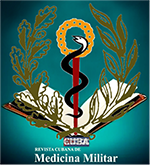Sinusal fungal ball as a consequence of long-term hydrocortisone therapy
Keywords:
drug-related side effects and adverse reactions, fungal infection, hydrocortisone, medication errorsAbstract
Introduction: Diagnosis of sinus fungal ball (SFB) remains a challenge in clinical practice. However, the use of corticosteroids in patients with autoimmune diseases may increase the risk of occurrence.
Objective: To report the occurrence of sinus fungal ball after long-term treatment with hydrocortisone in an autoimmune patient.
Case report: A 57-year-old patient, diagnosed with Addison's disease (AD) at age 21 and on continuous hydrocortisone therapy since then, presented to the healthcare facility. Initially, bacterial sinusitis was suspected, and he underwent multiple antibiotic courses over six months. On computed tomography, pseudopneumatization with an oval image compatible with a fungal ball was observed. Finally, SFB was removed nine months after the initial medical care. The level of causality between sinus fungal ball and hydrocortisone was "possible" and had a "moderate" severity level.
Conclusions: Healthcare professionals should consider the diagnosis of sinus fungal ball in immunocompromised patients during clinical practice and should remain alert to the possibility of fungal infections as side effects of long-term corticosteroid therapy.
Downloads
References
1. Akhondi H, Woldemariam B, Rajasurya V. Fungal Sinusitis. (In: StatPearls, ed.). Treasure Island (FL) [Internet]. StatPearls Publishing. 2024. [acceso: 13/10/2024]. Disponible en: https://pubmed.ncbi.nlm.nih.gov/31855340/
2. Alarifi I, Alsaleh S, Alqaryan S, et al. Chronic Granulomatous Invasive Fungal Sinusitis: A Case Series and Literature Review [Internet]. Ear, Nose Throat J. 2021; 100(5_suppl):720S-727S. DOI: 10.1177/0145561320904620
3. Marple BF, Gibbs SR, Newcomer MT, Mabry RL. Allergic fungal sinusitis-induced visual loss [Internet]. Am J Rhinol. 1999; 13(3):191-5. DOI: 10.2500/105065899781389740
4. Nassrallah S, Neagoş CM, Mocan SL, Neagoş A. Evaluation of the incidence of inflammatory and tumor pathology of nose and nasal sinus region [Internet]. Rom J Morphol Embryol. 2020; 61(4):1295-300. DOI: 10.47162/RJME.61.4.30
5. Ghogomu N, Kern R. Chronic rhinosinusitis: the rationale for current treatments [Internet]. Expert Rev Clin Immunol. 2017; 13(3):259-70. DOI: 10.1080/1744666X.2016.1220833
6. Wallis RS, Broder MS, Wong JY, Hanson ME, Beenhouwer DO. Granulomatous Infectious Diseases Associated with Tumor Necrosis Factor Antagonists [Internet]. Clin Infect Dis. 2004; 38(9):1261-5. DOI: 10.1086/383317
7. Ponikau JU, Sherris DA, Kern EB, Homburger HA, Frigasc E, Gaffey TA, et al. The Diagnosis and Incidence of Allergic Fungal Sinusitis [Internet]. Mayo Clin Proc. 1999; 74(9):877-84. DOI: 10.4065/74.9.877
8. Deutsch PG, Whittaker J, Prasad S. Invasive and Non-Invasive Fungal Rhinosinusitis-A Review and Update of the Evidence [Internet]. Medicina (Kaunas). 2019; 55(7):55070319. DOI: 10.3390/medicina55070319
9. Kelly WN, Arellano FM, Barnes J. Guidelines for submitting adverse event reports for publication [Internet]. Pharmacoepidemiol Drug Saf. 2007; 16(5):581-7. DOI: 10.1002/pds.1399
10. Naranjo CA, Busto U, Seller EM . Naranjo Adverse Drug Reaction Probability Scale. Clin Pharmacol Ther [Internet]. 1981; 30(2):239-45. DOI: 10.1038/clpt.1981.154
11. Hartwig SC, Siegel J, Schneider PJ. Preventability and severity assessment in reporting adverse drug reactions [Internet]. Am J Hosp Pharm. 1992 [acceso: 31/11/2024]; 49(9):2229-32. Disponible en: https://pubmed.ncbi.nlm.nih.gov/1524068/
12. Lee JS, Shin SY, Lee KH, Kim SW, Cho JS. Change of prevalence and clinical aspects of fungal ball according to temporal difference [Internet]. Eur Arch Oto-Rhino-Laryngology. 2013; 270(5):1673-7. DOI: 10.1007/s00405-012-2234-x
13. Yağmur AR, Çufalı ÖF, Çolak M, Çufal A, Kayal SA, Yeniçeri A, et al. Invasive fungal rhinosinusitis, clinical manifestations, and prognostic values: as case series audit [Internet]. Egypt J Otolaryngol. 2023; 39(1). DOI: 10.1186/s43163-023-00551-8
14. Wise BL, Peloquin C, Choi H, Lane NE, Zhang Y. Impact of age, sex, obesity, and steroid use on quinolone-associated tendon disorders [Internet]. Am J Med. 2012; 125(12):1228.e23-1228.e28. DOI: 10.1016/j.amjmed.2012.05.027
15. Llanos RQ, Ramírez RR, Palacios MT, Flores CF, Borda-Olivas A, Castillo RA, et al. Health Survey in a Peruvian health system (ENSSA): design, methodology and general results [Internet]. Rev Saude Publica. 2019; 53:33. DOI: 10.11606/S1518-8787.2019053001135
16. Bhattacharya S, Kubiha S, Tyagi P. Fungi and Endocrine Dysfunction. In: Feingold KR, Anawalt B, Blackman MR. Editorial: South Dartmouth (MA): MDText.com, Inc.; [Internet]. 2000. [acceso: 20/10/2024]. Disponible en: https://www.ncbi.nlm.nih.gov/books/NBK572246/
17. World Health Organization. Global Programme on Evidence for Health Policy. [Internet]. VigiAccess; 2024. [acceso: 22/10/2024]. Disponible en: https://www.vigiaccess.org/
Published
How to Cite
Issue
Section
License
Copyright (c) 2025 Rony Ludeña-Yance , Patricia Yacono-Ruiz, Rosa Campos-Yaipen, Pierre-Estherlin Mendoza-Montoya, Jose Fernando Salvador-Carrillo

This work is licensed under a Creative Commons Attribution-NonCommercial-ShareAlike 4.0 International License.
Authors who have publications with this Journal accept the following terms:
- The authors will retain their copyright and guarantee the Journal the right of first publication of their work, which will simultaneously be subject to the Creative Commons Attribution License. The content presented here can be shared, copied and redistributed in any medium or format; Can be adapted, remixed, transformed or created from the material, using the following terms: Attribution (giving appropriate credit to the work, providing a link to the license, and indicating if changes have been made); non-commercial (you cannot use the material for commercial purposes) and share-alike (if you remix, transform or create new material from this work, you can distribute your contribution as long as you use the same license as the original work).
- The authors may adopt other non-exclusive license agreements for the distribution of the published version of the work (for example: depositing it in an institutional electronic archive or publishing it in a monographic volume) as long as the initial publication in this Journal is indicated.
- Authors are allowed and recommended to disseminate their work through the Internet (e.g., in institutional electronic archives or on their website) before and during the submission process, which can produce interesting exchanges and increase citations. of the published work.






